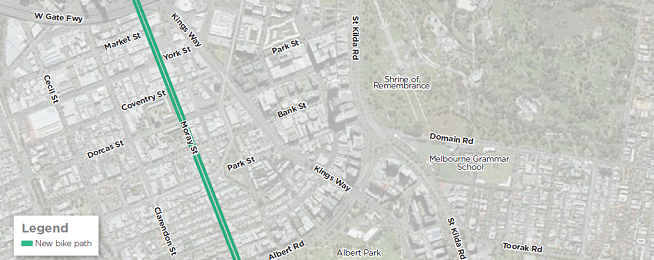Moray Street South Melbourne – potentially a great route into the city from the south via Albert Park – is set for a major upgrade.
Two design options were released for public consultation yesterday.
The upgrade is the work of Metro Tunnel, one of a number of network improvements planned to manage traffic disruption during the massive, lengthy project.
Moray Street has had bike lanes for many years, but the route's attractiveness has been hindered by hazardous roundabouts, lack of proper crossing at Albert Road, and angle parking on sections of the street at the city end.
Now at last there is an opportunity to fix these problems and improve the amenity of the street for all road users, residents and local shopkeepers.
The existing Moray Street bicycle lane facilities will be improved between Albert Road and Queensbridge Street, and will include safer connections to the Kavanagh Street and Queensbridge Street bike paths.
The City of Melbourne will also install an additional bike path along Kavanagh Street in late 2017 and along Southbank Boulevard in 2018.
Intersections at Albert Road, Coventry Street, Dorcas Street, York Street and Market Street will be made safer by creating a slower speed environment using kerb extensions and raised zebra pedestrian crossings.
The current bike crossing from Albert Road into Moray Street will also be formalised by providing a crossing on the west side of the Albert Road intersection.
Two main options have been exposed for comment: one is a protected bike lane set on the kerb side of the parked cars; and the other is a double buffered bike lane similar to that in Clarendon Street, East Melbourne.
The first option, described as the “preferred" option in the documentation, is not practicable in the assessment of Bicycle Network as the lane is just 1.25m wide plus a buffer, far short of the desired 2.0m required for such a facility.
In a commuter bike lane, a faster bike has to be able to safely get around a more leisurely rider. This is not possible at 1.25m width.
However, the other option, the on-road double buffer alternative (a la Clarendon St, East Melbourne, which has been shown to work well – safe and attractive to riders) probably can be provided to an acceptable standard provided the available road space is judiciously allocated, and the roundabouts are designed to current best-practice standard.
If this option is to be done correctly, the angle parking must be converted to parallel parking – there is insufficient space on the street to permit cars to reverse safely across the bike lane.
This should not be controversial as this area has enormous volumes of car parking available nearby under the freeway structure.
Make sure you comment on the proposal by visiting the project feedback website.
There are also two information sessions to learn more about the proposed Moray Street bicycle lane. Melbourne Metro staff will be available to answer questions and explain the information that will be on display at the Theatrette, South Melbourne Town Hall, Fishley Street, South Melbourne.
- 2pm – 4pm, Friday 25 August 2017
- 6pm – 8pm, Tuesday 29 August 2017
There is further information at metrotunnel.vic.gov.au.


